
- Home Page
- Accepted
Paintings & Copies - Doubtful
Attributions - Doubtful Textual References
- Alternative
Titles - Collectors &
Museums - Bibliography
- Search Abecedario
- Watteau &
His Circle
Le Bal champêtre (copy 1)
Entered January 2016
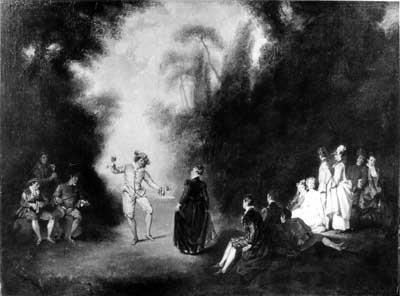
Bucharest, Muzeul National de Arta al Româniel, inv. 71806/2370
Oil on canvas
69.2 x 95 cm
ALTERNATIVE TITLES
Gallant Scene
PROVENANCE
The painting entered the museum’s collection in 1966. Its previous whereabouts are unknown.
EXHIBITIONS
Contu, Modele de compartament (2015), 114-15.
REMARKS
This copy is surprisingly faithful, and it measurements correspond essentially to those cited on the Couché engraving.
Le Bal champêtre (copy 2)
Entered January 2016
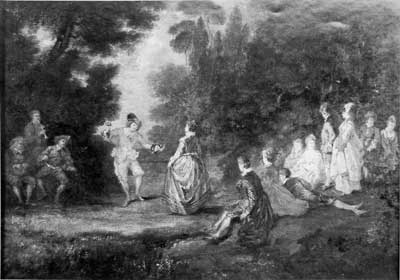
Whereabouts unknown
Oil on canvas (?)
Measurements unknown
ALTERNATIVE TITLES
Le Menuet
PROVENANCE
Paris, collection of Daniel Saint (1778-1847; miniaturist). His sale, Paris, May 4, 1846, lot 70: “DU MÊME [WATTEAU (Antoine) . . . Le menuet. Un Giles danse en s’accompagnant de castagnettes et d’un orchestre formé de trois musiciens assis à gauche. Du côté opposé six personnages debout et assis dans diverses attitudes. Tableau en forme de frise, qui parait être l’esquisse de celui qui était dans la galerie du duc d’Orléans.”Sold for 80 francs according to the annotated copy of the sale catalogue in the Rijksbureau voor Kunsthistorische Documentatie.
Paris, collection of Édouard Alphonse James de Rothschild (1868-1949; financier). A photograph of the painting in the Service de documentation, Département des peintures, Musée du Louvre, is marked on the verso as being in the Rothschild collection. Unlike the Watteau original, this version has less space devoted to the landscape and sky, resulting in a more horizontal composition that corresponds to the term “forme de frise” used by de Goncourt.
SELECT BIBLIOGRAPHY
Goncourt, Watteau (1875), under cat. 112.
Dacier, Vuaflart, and Hérold, Jean de Jullienne et les graveurs (1921-29), under cat. 293.
Adhémar, Watteau (1950), under cat. 132.
REMARKS
Although the picture was given to Watteau himself when sold from the Saint collection, it was evident that it was not finished like Watteau’s established works and thus was called an “esquisse.” A photograph of the painting, by then in the Rothschild collection, reveals its sketchy manner. Goncourt reports that the Saint picture was much contested at the time. The relatively low price at which it sold, unlike other Watteau paintings in the Saint collection that brought several thousand francs each, confirms the doubt about the attribution.
Le Bal champêtre (copy 3)
Entered January 2016
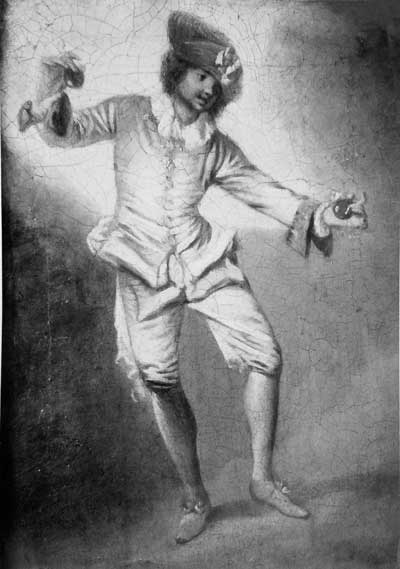
Whereabouts unknown
Oil on canvas
24.5 x 30 cm
ALTERNATIVE TITLES
The Castanette Player
Le Joueur de castagnettes
PROVENANCE
London, Duke of Richelieu collection; His sale, London, Christie’s, May 18, 1848, lot. 82: “Watteau . . . A figure in a white dress dancing, and playing the castinets.” According to the annonated copy of the sale catalogue in the National Arts Library, London, the painting was bought for £5.5.1 by Rutley.
London, Collection of the Viscount de Castelruiz (or Castelbruiz). The former spelling of the family name corresponds to that given at a London sale of Old Master drawings on April 27-30, 1846. The latter, less likely spelling was reported at the 1851 sale of The Castanette Player.
London, collection of Thomas Capron. His sale, London, Christie’s, May 3, 1851, lot. 55: “WATTEAU . . . The CASTANETTE PLAYER. The original sketch for the figure in the Orleans Picture. From the Collection of the Comte de Castelbruiz.”
Paris, Schnell collection. His sale, Paris, May 18-19, 1922, lot 78: “MERCIER (Philippe) . . . Le Joueur de Castagnettes. Toile. Haut., 0m 3; larg., 0m 23.” The picture sold for 650 francs according to an annotated copy of the sale catalogue in Watson Library, Metropolitan Museum of Art, New York. It was bought by Charles Couturieux, as noted in a letter dated April 7, 1959, from Jean Lévy to Hélène Adhémar, now in the Service de documentation, Département de peintures, Musée du Louvre.
Paris, collection of Charles Couturieux. Dacier, Vuaflart and Hérold reported that a copy of the lot description from the Capron sale catalogue was pasted on the verso side of the painting. According to Jean Lévy’s letter of April 7, 1959, the painting was still in the Couturieux collection at that date.
SELECT BIBLIOGRAPHY
Dacier, Vuaflart, and Hérold, Jean de Jullienne et les graveurs (1921-1929), under cat. 124 and 293.
Rey, Quelques satellites, 90.
Adhémar, Watteau (1950), under cat. 224.
REMARKS
This picture repeats just the principal male dancer in Le Bal champêtre. As an independent figure, it recalls Watteau’s celebrated L’Indifférent in the Louvre, which also shows an actor in an attitude of the dance. But L’indifférent also includes a landscape setting whereas here just some brushwork fills in the background in a meaningless way.Rey, like other scholars of that time, believed that this painting was actually by Watteau and, moreover, that it inspired Mercier’s Le Danceur aux catagnettes. That proposed relationship confuses the issue unnecessarily since both the Mercier composition and this painting derive from Watteau’s Le Bal champêtre.
In 1984 Rosenberg claimed that the Victoria Museum in Bath owned a painting after the female dancer in Le Bal champêtre. This might lead one to think that there was a pendant to The Castanette Player but, in fact, the work in the Victoria Museum is a sanguine drawing after the female dancer (Rosenberg and Prat R37).
Le Bal champêtre (copy 4)
Entered November 2016
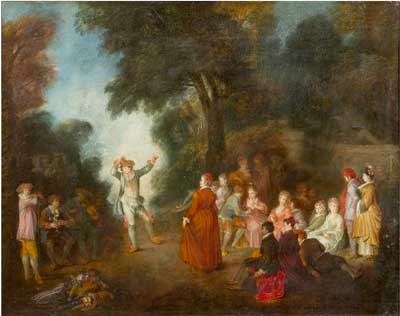
Milan, collection of Ottavio Fabbri
Oil on canvas
57 x 73 cm
ALTERNATIVE TITLES
Danse des comédiens dans un parc
PROVENANCE
Milan, collection of Dino Fabbri, c. 1980; by descent to his son Ottavio Fabbri.
REMARKS
This painting was previously believed to be by Watteau himself, perhaps by the young Watteau. However, as is evident, it is essentially just a copy after Le Bal champêtre. The major difference is that there is an extra figure at the left – a comedian who does not seem to have been derived from a specific source in Watteau’s oeuvre.
Le Bal champêtre (copy 5)
Entered June 2021; revised July 2021
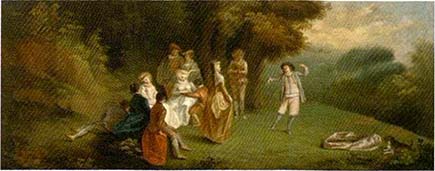
Whereabouts unknown
Oil on canvas
56.8 x 139.3 cm
ALTERNATIVE TITLES
A Fête Champêtre
PROVENANCE
London, sale, Christie’s South Kensington, July 6, 2005, lot 153: “MANNER OF JEAN-ANTOINE WATTEAU / A Fête Champêtre / oil on canvas / 22 3/8 x 54 7/8 in. (56.8 x 139.3 cm.) Estimate £2,000-4,000 / US $3,700-7,300/ €3,000-5,900.” Sold for £3,000.
REMARKS
This large version of Watteau’s composition is based on the Couché engraving. While it is a relatively faithful copy in regard to the figures, it has been recast into an exaggerated, horizontal format and the landscape is unrelated to Watteau’s.